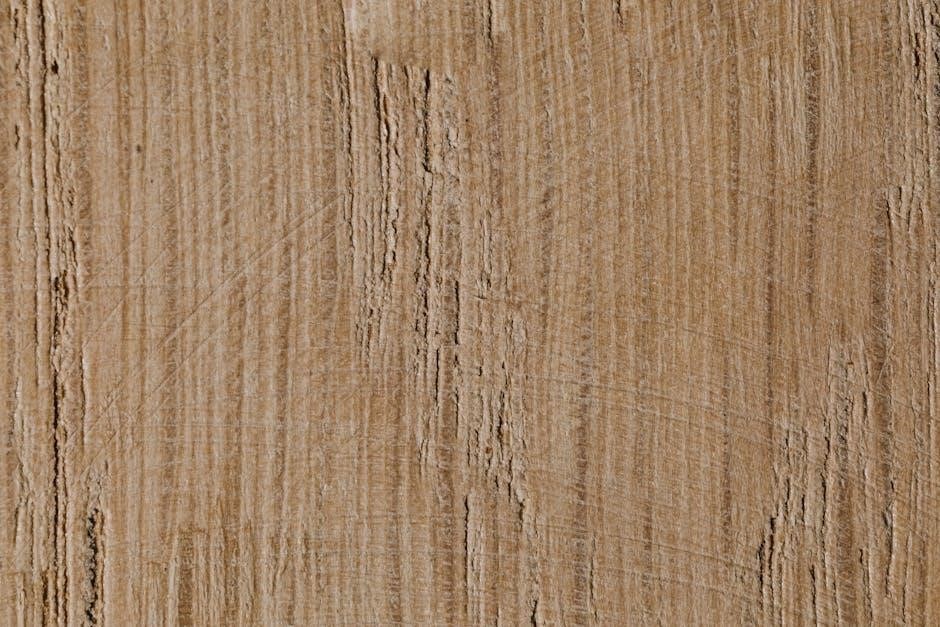wood hardness chart pdf
The wood hardness chart pdf provides a comprehensive list of wood species and their hardness ratings‚ categorized for easy reference‚ using the Janka hardness test method‚ on the internet today‚ for users․
Definition of Wood Hardness
Wood hardness refers to the resistance of wood to denting and wear‚ measured by the force required to embed a steel ball into the wood․ This measurement is crucial in determining the durability and suitability of wood for various applications․ The definition of wood hardness is closely tied to the Janka hardness test‚ which is a widely accepted method for evaluating wood hardness․ According to the test‚ wood hardness is defined as the force required to push a steel ball with a diameter of 11․28 millimeters into the wood to a depth of half the ball’s diameter․ This definition provides a standard basis for comparing the hardness of different wood species‚ allowing users to make informed decisions when selecting wood for their needs․ The wood hardness chart pdf provides a comprehensive list of wood species and their corresponding hardness ratings‚ making it easier to understand and apply the definition of wood hardness in practice․ The information is readily available on the internet‚ facilitating access to this important aspect of wood evaluation․
Janka Hardness Test Method
The Janka hardness test method is a standardized procedure for measuring the hardness of wood‚ developed by Gabriel Janka in 1906․ This method involves measuring the force required to embed a steel ball with a diameter of 11․28 millimeters into the wood to a depth of half the ball’s diameter․ The test is typically performed on the wood’s tangential surface‚ and the results are expressed in pounds per square inch (psi) or Newtons․ The Janka hardness test method is widely accepted as a reliable and accurate means of evaluating wood hardness‚ and it is commonly used in the wood industry to compare the hardness of different wood species․ The test method is also used to evaluate the suitability of wood for various applications‚ such as flooring and furniture making․ The wood hardness chart pdf provides a comprehensive list of wood species and their corresponding Janka hardness ratings‚ which are determined using this test method․ The Janka hardness test method is an important tool for wood evaluation‚ and it is widely used in the industry․ The test results are used to determine the hardness of wood species․

Wood Hardness Chart Organization
Alphabetical Organization of Wood Species
Organization by Hardness

Interpreting the Wood Hardness Chart
Understanding Janka Values
The Janka values are a measure of the hardness of wood‚ with higher values indicating harder wood․ The values are determined by the Janka hardness test‚ which measures the force required to embed a steel ball into the wood․ The test is widely used in the wood industry to compare the hardness of different wood species․ The Janka values are usually expressed in pounds per square inch (psi) and range from around 400 psi for softwoods to over 3‚000 psi for some hardwoods․ The values can be used to determine the suitability of a particular wood species for a given application‚ such as flooring or furniture making․ By understanding the Janka values‚ woodworkers and designers can make informed decisions about the type of wood to use for a project․ The Janka values are an important factor in evaluating the durability and performance of wood products․ Wood hardness chart pdf provides a comprehensive list of Janka values for various wood species․
Using the Chart for Selection

The wood hardness chart pdf is a valuable tool for selecting the right wood species for a particular project․ By using the chart‚ woodworkers and designers can compare the hardness of different wood species and make informed decisions about the type of wood to use․ The chart can be used to select wood species that are suitable for high-traffic areas‚ such as flooring‚ or for applications where durability is important‚ such as furniture making․ The chart can also be used to select wood species that are resistant to denting and wear‚ which is important for applications such as countertops and table tops․ Additionally‚ the chart can be used to select wood species that are suitable for outdoor applications‚ such as decking and siding․ By using the wood hardness chart pdf‚ users can ensure that they select the right wood species for their project‚ which can help to ensure the longevity and performance of the finished product; The chart is easy to use and provides a quick and easy way to compare the hardness of different wood species․

Examples of Wood Hardness Values
Wood hardness values range from 410 for Basswood to 3680 for IPE‚ providing a comprehensive comparison of wood species‚ using the Janka hardness test method‚ on the internet today‚ for users everywhere․
Softwoods and Hardwoods
The wood hardness chart pdf differentiates between softwoods and hardwoods‚ with softwoods generally having lower hardness ratings‚ such as Yellow Pine with a rating of 690‚ and Douglass Fir with a rating of 660․ Hardwoods‚ on the other hand‚ tend to have higher hardness ratings‚ with examples including IPE‚ also known as Brazilian Walnut‚ with a rating of 3680‚ and Mesquite‚ with a rating of 2345․ The Janka hardness test method is used to determine these ratings‚ providing a standardized measure of the hardness of various wood species․ This information is useful for builders‚ designers‚ and researchers‚ who need to select the most suitable wood species for their projects‚ taking into account factors such as durability and resistance to wear and tear․ The wood hardness chart pdf provides a comprehensive and organized list of wood species‚ making it easier to compare and select the most appropriate options․ The chart is a valuable resource for anyone working with wood‚ and is widely available on the internet today․
Comparing Wood Hardness Values
The wood hardness chart pdf enables users to compare the hardness values of different wood species‚ allowing for informed decisions when selecting wood for various applications․ By examining the chart‚ it becomes clear that some wood species‚ such as IPE and Massaranduba‚ have significantly higher hardness ratings than others‚ like Basswood and Butternut․ This comparison is useful for identifying the most durable and resistant wood species‚ which is essential for projects that require withstanding heavy use or harsh environments․ The chart also facilitates the comparison of domestic and exotic wood species‚ providing a comprehensive overview of the available options․ Additionally‚ the wood hardness chart pdf can be used to evaluate the hardness of different wood species in relation to their density and weight‚ offering a more detailed understanding of their properties and characteristics․ This information is valuable for professionals and individuals working with wood‚ and is readily available on the internet today in the form of a downloadable pdf․
